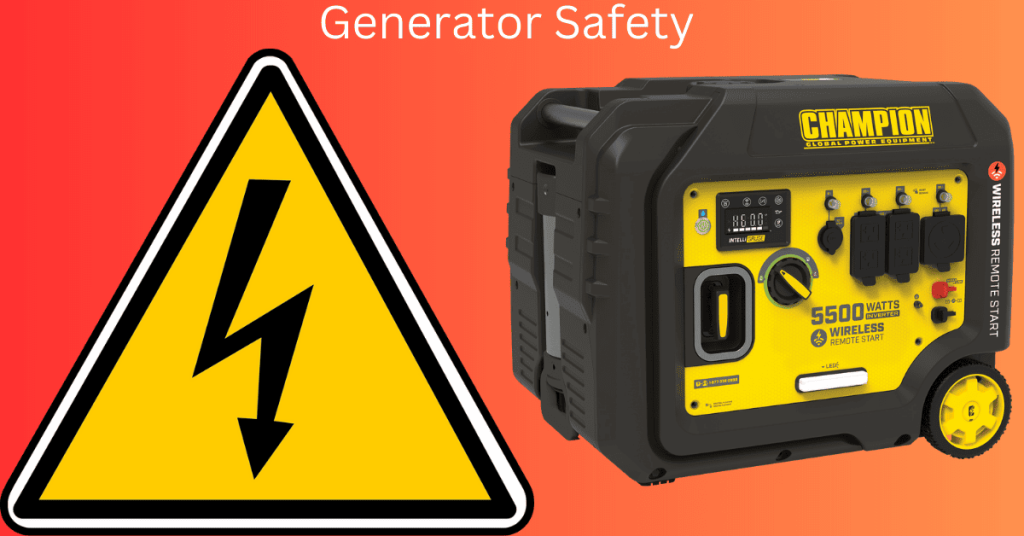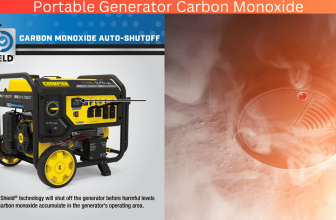Did you know that portable generator-related carbon monoxide (CO) poisoning has caused an average of 81 deaths per year in the United States from 2005 to 2017? As a team of AI language models, we want to help you become power wise and essential safety-conscious when it comes to portable generators.
These machines can provide essential power during a power outage or outdoor activities, but it is important to use them correctly to prevent accidents, injuries, and fatalities. In this article, we will cover the essential safety tips that you need to know when using portable generators.
We will guide you through how to choose the right generator for your needs, properly set it up and install it, practice safe operation, prevent carbon monoxide poisoning, maintain and store your generator properly, and be prepared for emergencies. Whether you are a seasoned generator user or a first-time buyer, this article will equip you with the knowledge and skills to become a power wise generator user and ensure the safety of yourself and others.
Key Takeaways
- Proper use, setup, installation, and maintenance of portable generators can prevent accidents, injuries, and fatalities.
- Carbon monoxide poisoning prevention measures, such as outdoor use and the use of carbon monoxide detectors, are essential for safe operation.
- Symptoms of carbon monoxide poisoning, including headache, dizziness, nausea, and fatigue, require immediate medical attention.
- Following manufacturer and local guidelines, obtaining necessary permits or licenses, and prioritizing safety in emergencies are crucial for responsible and safe use of portable generators.

Choose the Right Generator for Your Needs
You’ll want to make sure you choose the right generator for your needs, so that you have the essential power you need in case of an emergency or power outage.
The first thing you need to consider is your power requirements. Think about the appliances and electronics that you want to power, and add up their wattage. This will help you determine the size of the generator you need.
Next, think about the fuel type you prefer. Portable generators can run on gasoline, propane, or diesel. Gasoline is the most common fuel type, but it can be difficult to store for long periods of time. Propane and diesel are more expensive, but they can be stored for longer periods without going bad.
Finally, consider the noise level of the generator. If you plan on using it in a residential area, you’ll want to choose a model with a lower decibel rating.
Now that you’ve chosen the right generator for your needs, it’s important to properly set up and install your generator to ensure safe and efficient operation. By following the manufacturer’s instructions, you can ensure that your generator is properly grounded, and that it is placed in a well-ventilated area away from windows and doors. This will prevent carbon monoxide poisoning, which can be deadly.
So, before you start your generator, be sure to read the instructions carefully and take all necessary precautions.
Properly Set Up and Install Your Generator
Once you’ve chosen the perfect spot for your generator, it’s time to get it up and running to ensure uninterrupted power supply during emergencies. Proper setup and installation of your generator is crucial for your safety and the safety of those around you. Here are a few steps to ensure your generator is installed correctly:
| Step | Action |
|---|---|
| 1 | Read the manufacturer’s manual thoroughly before beginning installation. |
| 2 | Choose a flat, dry surface away from doors, windows, and vents to install the generator. |
| 3 | Install a transfer switch to prevent backfeed, which can cause electrocution or damage to your generator. |
It’s important to remember that improper installation of a portable generator can lead to serious injury or even death. Taking the time to properly set up your generator can prevent accidents and ensure that you have a reliable source of power during an emergency.
In addition to setting up your generator correctly, it’s important to have a regular maintenance schedule to keep it in good working condition. Practice safe operation of your generator by following the manufacturer’s instructions and keeping it clean and well-maintained. Remember, safety is key when it comes to using a portable generator, so take the necessary precautions to keep yourself and others safe.
Practice Safe Operation
To keep things running smoothly, it’s important to know how to safely operate your generator. First and foremost, make sure you’re familiar with the manufacturer’s instructions and warnings.
Always start the generator outside in a well-ventilated area, away from doors, windows, and vents. Keep it at least 10 feet away from your home or any other building to prevent carbon monoxide from entering the enclosed space.
Next, be sure to use heavy-duty extension cords specifically designed for outdoor use. Never connect multiple extension cords together or plug your generator into a wall outlet. This can cause back-feeding, which can be dangerous to you and your neighbors. Always plug appliances directly into the generator or use a properly rated transfer switch.
Lastly, never refuel your generator while it’s running. Turn it off and let it cool down before refueling. Store fuel in a safe, well-ventilated area, away from any heat sources or flames. And always keep a fire extinguisher nearby in case of an emergency.
By following these safety guidelines, you can ensure that your generator operates smoothly and safely. However, there’s one more important step to prevent carbon monoxide poisoning. Let’s take a look at how to do this in the next section.
Prevent Carbon Monoxide Poisoning
Make sure you’re aware of the risks of carbon monoxide poisoning and take the necessary precautions when operating a generator. Carbon monoxide is an odorless, colorless gas that can be deadly if inhaled. It is produced by the exhaust fumes of portable generators, which can build up quickly in enclosed spaces. To prevent carbon monoxide poisoning, it’s important to always use your generator outdoors, away from windows, doors, and vents that could allow the gas to enter your home or other enclosed areas.
In addition to using your generator outdoors, it’s important to take other precautions to prevent carbon monoxide poisoning. One way to do this is by installing carbon monoxide detectors in your home, especially near bedrooms and other areas where people sleep. These detectors can alert you if carbon monoxide levels become dangerously high. You should also be aware of the symptoms of carbon monoxide poisoning, which include headache, dizziness, nausea, and fatigue. If you or anyone else experiences these symptoms while using a generator, get outside immediately and seek medical attention.
To help you understand the risks of carbon monoxide poisoning and how to prevent it, we’ve created a table that shows the recommended distance between your generator and your home or other enclosed areas. This table can help you make sure that you’re using your generator safely and that you’re giving yourself and your family the best chance of avoiding carbon monoxide poisoning. Remember, the best way to stay safe when using a portable generator is to use it outdoors, away from enclosed spaces, and to take all necessary precautions to prevent carbon monoxide poisoning.
As important as it is to prevent carbon monoxide poisoning, it’s also important to maintain and store your generator properly. By following the manufacturer’s instructions for maintenance and storage, you can help ensure that your generator stays in good condition and continues to work properly for years to come.
Maintain and Store Your Generator Properly
Taking care of your generator and storing it properly is key to ensuring it runs smoothly and lasts for years to come. One of the simplest things you can do is to keep it clean. After each use, wipe it down with a damp cloth to remove any dirt or debris. This will help prevent rust and corrosion from forming on the metal parts.
Another important step is to change the oil regularly. This will keep the engine running smoothly and prevent it from overheating. Check the owner’s manual for specific instructions on when and how to change the oil. It’s also a good idea to check the oil level before each use, and top it off if necessary.
When it comes to storing your generator, make sure to keep it in a dry, well-ventilated area. This will help prevent moisture from building up, which can lead to rust and corrosion. It’s also a good idea to cover it with a tarp or other protective covering to keep it clean and dry.
By following these simple maintenance and storage tips, you can ensure that your generator will be ready to go when you need it most.
Taking care of your generator is just one part of being prepared for emergencies. In the next section, we’ll cover some essential safety tips to help you stay safe when using your generator in a power outage or other emergency situation.
Be Prepared for Emergencies
Are you ready for unexpected situations? Emergencies can strike at any time, and it’s important to be prepared.
When it comes to portable generators, there are a few things you can do to ensure you’re ready for any emergency that may arise. First and foremost, make sure you have enough fuel on hand to run your generator for at least a few days. You never know how long an emergency situation will last, so it’s always better to be safe than sorry.
Another important step is to have a plan in place for how you’ll use your generator during an emergency. This means deciding which appliances and devices you’ll power, and how you’ll prioritize them. For example, you may want to make sure your refrigerator and freezer stay cold, and that you have a way to charge your phone or other communication devices. Having a plan in place will help you use your generator more efficiently and effectively.
Remember, safety should always be your top priority when using a portable generator. This means following all manufacturer guidelines and regulations, as well as any local regulations in your area.
In the next section, we’ll discuss some of the most important guidelines and regulations you should be aware of. By being prepared for emergencies and following all necessary guidelines, you can ensure that you and your loved ones stay safe during any unexpected situations.
Follow Local Regulations and Guidelines
Now that we know the importance of being prepared for emergencies when it comes to using portable generators, let’s move on to the next step – following local regulations and guidelines. It’s not enough to just have a generator on hand, we need to ensure that we’re using it safely and legally.
First and foremost, it’s important to check with your local government to see if there are any regulations or guidelines in place regarding the use of generators. Some areas may have specific noise level restrictions or designated areas where generators can be used. It’s also important to be aware of any permits or licenses that may be required.
In addition to checking local regulations, it’s important to follow the manufacturer’s instructions for your specific generator. This includes properly grounding the generator, using the correct fuel and oil, and ensuring adequate ventilation. Failure to follow these instructions can not only lead to safety hazards but can also void any warranties.
By taking the time to research and follow local regulations and guidelines, as well as manufacturer instructions, we can ensure that we’re using our portable generators safely and responsibly. This not only protects ourselves and our families but also our neighbors and the community. Let’s make sure we’re being power-wise and doing our part to maintain a safe environment for all.
Check out these tips for following local regulations and guidelines:
- Research your local government’s regulations on generator usage.
- Obtain any necessary permits or licenses.
- Follow the manufacturer’s instructions for your specific generator.
- Be aware of noise level restrictions and designated areas for generator use in your area.
Frequently Asked Questions
How do I calculate the wattage needed for my specific appliances and devices?
Let’s calculate the wattage needed for our appliances and devices. To do so, we need to find the rated power consumption of each item and add them up. This will ensure we get a generator with enough power to meet our needs.
Can I use my portable generator indoors?
Using a portable generator indoors is dangerous due to carbon monoxide poisoning. We strongly advise against it. Always operate your generator outside, away from open windows and doors to ensure your safety.
How often should I change the oil in my generator?
We recommend changing the oil in our generator every 50 hours of use or at least once a year. Regular oil changes keep the engine running smoothly and prolong its lifespan. Don’t neglect this simple maintenance task for optimal performance.
Can I use my generator during a power outage caused by a natural disaster?
Absolutely! Using our generator during a natural disaster power outage was a game-changer. We were able to keep our essentials running while our neighbors were left in the dark. It’s a must-have for any emergency preparedness kit.
Is it safe to connect my generator directly to my home’s electrical system?
No, it’s not safe to connect a generator directly to our home’s electrical system. This can cause backfeeding, electrocution, and damage to the generator. We should always use a transfer switch installed by a licensed electrician.
Conclusion
In conclusion, being power wise means not only choosing the right generator for your needs, but also properly setting it up, practicing safe operation, preventing carbon monoxide poisoning, maintaining and storing it properly, and being prepared for emergencies. It’s important to follow local regulations and guidelines to ensure the safety of yourself, your family, and your community.
As the saying goes, “better safe than sorry.”Taking the necessary precautions and being responsible when using a portable generator can prevent accidents and potentially life-threatening situations. So, let’s all be power wise and prioritize safety when using portable generators.





